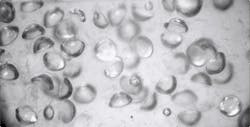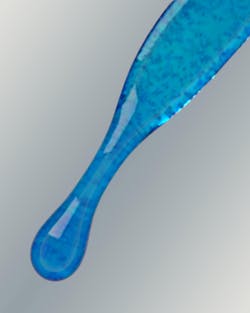Harvard John A. Paulson School of Engineering & Applied Sciences (SEAS; Cambridge, MA) researchers just created a first-of-its-kind metafluid that uses a suspension of small elastomer spheres—between 50 to 500 μm—that buckle under pressure and radically change the properties of the fluid (see Fig. 1 and video).
Why is this so intriguing? The team’s metafluid can be used for a range of applications, including hydraulic actuators to program robots, intelligent shock absorbers that can dissipate energy (depending on the intensity of the impact), and optical devices that transition from clear to opaque.
Metamaterials—artificially engineered materials with properties determined by their structure rather than composition—are already widely used within a wide range of applications. Most metamaterials, such as the metalenses pioneered by Federico Capasso’s lab at Harvard SEAS, are solid. But unlike their solid counterparts, metafluids’ superpower is that they can flow and adapt to the shape of their container.
Metafluids
It all started when Adel Djellouli, a research associate in materials science and mechanical engineering at SEAS, had an epiphany four years ago after brainstorming about materials while having coffee with colleague Ben Gorissen: there’s a giant gap within the field when it comes to fluids. Most of the advances during the past 20 years were achieved with solid metamaterials, and very few examples exist in literature with metafluids.
“The building block of our metafluid, which is a highly deformable hollow shell, is a system that I studied extensively during my Ph.D. when I was working on artificial microswimmers—and I always wanted to explore their collective behavior,” says Djellouli. “We were far from imagining how rich the system would end up being.”
So Djellouli and colleagues set out to create a metafluid that provides a platform for programmable viscosity, compressibility, and optical properties.
“Our metafluid is a conventional liquid that contains a suspension of gas-filled elastic capsules (see Fig. 2),” explains Djellouli. “Introducing these shells allows us to endow the liquid with programmable compressibility, but also an elastic phase transition when shells snap—which results in a plateau at a threshold pressure, reminiscent of 1 order thermodynamic phase transition.”
This “shell snapping” alters the geometry of the building blocks and takes it from convex to concave—drastically changing its scattering properties. “In practice, this translates to transitioning from opaque to transparent when we index-match the continuous phase with the shell’s material,” Djellouli says.
The metafluid’s design is straightforward, thanks to a simple geometry—both at the macro and micro levels. This simplicity makes “fabrication easy and scalable,” says Djellouli. “We can tune many properties—thermodynamic, optical, or rheological—of the metafluid. It introduces both softness and control to a simple robot, and we’ve shown nontrivial flow properties we think have secrets to unravel. We want people to adopt this new system and play with it!”
Tunable optical properties and non-Newtonian behavior
When exposed to a change in pressure, the metafluid changes its optical properties.
Round capsules scatter light and make the liquid opaque. But when pressure is applied, the capsules collapse into microlenses that focus light and make the liquid transparent.
Djellouli and colleagues also showed that when the metafluid’s capsules are spherical, it acts like a Newtonian fluid—its viscosity changes only in response to temperature. But when the capsules collapse, the suspension transitions into a non-Newtonian fluid and its viscosity changes in response to shear force. The greater the shear force, the more fluid (less viscous) it becomes.
Mindbendingly, this is the first metafluid known to transition between Newtonian and non-Newtonian states.
Metafluid fabrication
To fabricate their metafluid in a highly scalable way, the team turned to the lab of David A. Weitz, a professor of physics and applied physics at SEAS, where they produced hundreds of thousands of their highly deformable spherical capsules filled with air and suspended them within silicon oil.
As the pressure inside the liquid increases, the capsules collapse into a lens-like half sphere. When pressure is removed, the capsules pop back out into their spherical shape. This transition alters many of the liquid’s properties, including its viscosity and opacity, which can be tuned by changing the number, thickness, and size of the capsules within the liquid.
In a fun demonstration, the team showed they could use their metafluid to provide intelligence to a simple robot. They programmed the metafluid by loading it into a hydraulic robotic gripper and having it lift a heavy glass bottle, a delicate egg, and a tiny blueberry. For a traditional hydraulic system powered by simple air or water, a robot would require sensing or some type of external control to adjust its grip and lift all three objects without crushing them.
The beauty of the team’s metafluid is that no sensing is needed because it responds to different pressures and automatically adjusts the force of the gripper to lift the bottle, egg, and blueberry—no additional programming necessary.
They also went on to demonstrate a fluidic logic gate that can be reprogrammed by changing the composition of the metafluid.
One of the biggest surprises for the researchers was the metafluid’s flow properties—because its flow doesn’t depend solely on the difference of pressure between the inlet and outlet, but also its absolute pressure. “Shape transition gives rise to a rich behavior we’re still scratching the surface of,” says Djellouli.
A remaining challenge for the team is to scale beyond the lab and overcome air diffusion out of the membrane as they attempt to go smaller.
Energy applications?
While upstream from the applications, “exploring both energy conversion and storage is one big possible application, as well as tunable shock absorption—depending on the amplitude of the impact,” says Djellouli.
And based on its optical properties, the metafluid could be used as “an adaptable light filter that depends on the pressure,” Djellouli adds. “It can also be used as a power limiter for high-powered lasers—depending on how the transmission is configured to change with applied heating.”
The team’s now exploring the metafluid’s tunable acoustic properties and thermal properties.
FURTHER READING
A. Djellouli et al., Nature, 628, 545–550 (2024); https://doi.org/10.1038/s41586-024-07163-z.
About the Author
Sally Cole Johnson
Editor in Chief
Sally Cole Johnson, Laser Focus World’s editor in chief, is a science and technology journalist who specializes in physics and semiconductors.


